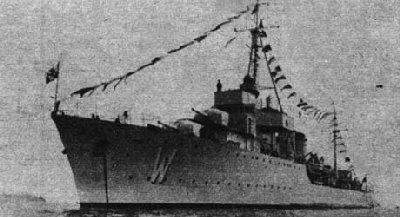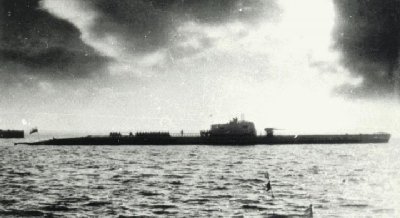|
The early 1920s spelt the end of the ambitious Polish naval programmes worked out in 1920, and settled the composition of the Polish Navy for the next decade: a force of 6 torpedo boats, 2 gunboats, 4 minesweepers and 6 river monitors. Such divergence between early projects and hard reality was not entirely due to economic and industrial problems: the country had almost 2000 miles of land border but only 90 miles of coastline.

ORP Wicher
The considerable investments made by the Polish Government in Gdynia and the gradual stabilisation of Poland's economy brought about the possibility of additional military expenditure, and in 1924 the KMW (Kierownictwo Marynarki Wojennej = Directorate of the Navy) drew up a so-called "small programme" which envisaged the building of 2 cruisers, 6 destroyers, 12 torpedo boats and 12 submarines over a period of twelve years. A naval base would have to be built at Gdynia to house and supply the Polish ships as well as those of the French Navy which, according to the 1921 alliance, could be expected in case of war with Russia. In 1925 the KMW asked for the authorisation of 9 submarines (3 minelaying) and the necessary shore facilities as well, but by mid 1925 the Polish currency was in serious trouble and all but the minelaying submarines fell victim to budget cuts. Quite unexpectedly, however, the KMW received from the War Ministry permission to order two additional destroyers from France. In fact, as there were no naval yards on Poland soil all five ships were ordered in 1926 from French yards. Delivery was only concluded in 1932: Wicher, the fastest built, was delivered 20 months late and Burza took 6 years to built. The ships had many design and construction faults, which discouraged the KMW from placing order with French yards for some time. The Great Depression buried any hopes of completing the "small programme" and by the mid 1930s no new ships had been laid down. In 1933 the economic situation improved and new orders were possible. Four replacement minesweepers were ordered from Polish yards, which produced quite satisfactory boats in a reasonable time - a notable achievement for the Polish shipbuilding industry which proved its ability to produce warships. The bigger ships had to be ordered abroad, however. In 1934 an order for a minelayer was placed in France, but this vessel was widely criticised for its poor fighting qualities and its high cost, which was equivalent to that of a large destroyer. A much better bargain was obtained from Britain. Two "super destroyers" were ordered from Samuel White, resulting in a pair of splendid boats which were far in advance of other designs at the time.

ORP Rys
By the end of the 1920s the Polish community had become widely interested in maritime affairs, thanks to the development of Gdynia: spontaneous local action had produced funds for the expansion of the Navy. In 1930 the Reichsminister Treviranus questioned the legality of the Polish possession of Pomerania, and thereupon the Polish public organisations arranged a nationwide subscription for the building of a submarine. By the middle of 1935 the equivalent of Ł 200,000 had been raised from voluntary contributions, and with this money the KMW ordered a submarine from the Koninklijke Maatschappijk de Schalde, adding another boat from its own fund. The Dutch yard had been chosen because of a distrust of French yards and because of the outstanding reputation of the Dutch shipbuilding industry. Both ships were delivered in 1939 and proved to be exceptionally successful. It was also planned to build 17 MTBs from public subscription - one from each of the Polish provinces.
The introduction of national service in Germany in 1935 and the militarisation of the Rhineland posed problems for the defence of Poland. Steady economic growth and political changes had made Polish military planning receptive to new ideas. The six-year rearmament programme authorised in 1936 promised a thorough modernisation of the Polish armed forces, based mainly on the country's own industrial capability. A large industrial complex, located between the Vistula and San rivers (far from both the German and Russian borders) had been planned in the late 1930s, but unfortunetely little had been completed before the outbreak of war.
The preliminary programme worked out by the KMW in 1936 called for the expantion of the Navy to a force of 8 destroyers, 12 submarines, 1 minelayer, 12 minesweepers and 10 MTBs during the six-year programme. However, this was not approved in its entirety, and reductions were made in all categories of ships. A total of 2 destroyers, 2 submarines, 2 minesweepers and 2 MTBs had been ordered before the war, and a pair of 300 t minesweepers and 5 MTBs (2 built from public subscriptions) were envisaged, together with the modernisation of the Wicher class destroyers. The destroyers, minesweepers and three of the MTBs had to be built in Poland. Only 2 minesweepers of this programme had been delivered before the war.
from Convay's All the Worlds's Fighting Ships
|